Organizing your hand tools systematically and efficiently saves you time and ensures your workspace remains tidy and clutter-free. Whether you are a DIY enthusiast or a professional, having easy access to your tools can make a world of difference in your productivity and efficiency.
In this blog post, I will share some practical tips and strategies for organizing your hand tools to maximize efficiency and accessibility. From tool storage solutions to labeling systems, we will explore various techniques to transform your chaotic garage workshop into a well-organized haven for all your projects.
By following these tips, you can find the right tool quickly and understand your tools, which can help you avoid unnecessary purchases. So, let’s dive right in and discover the secrets to efficient and accessible hand tool organization!
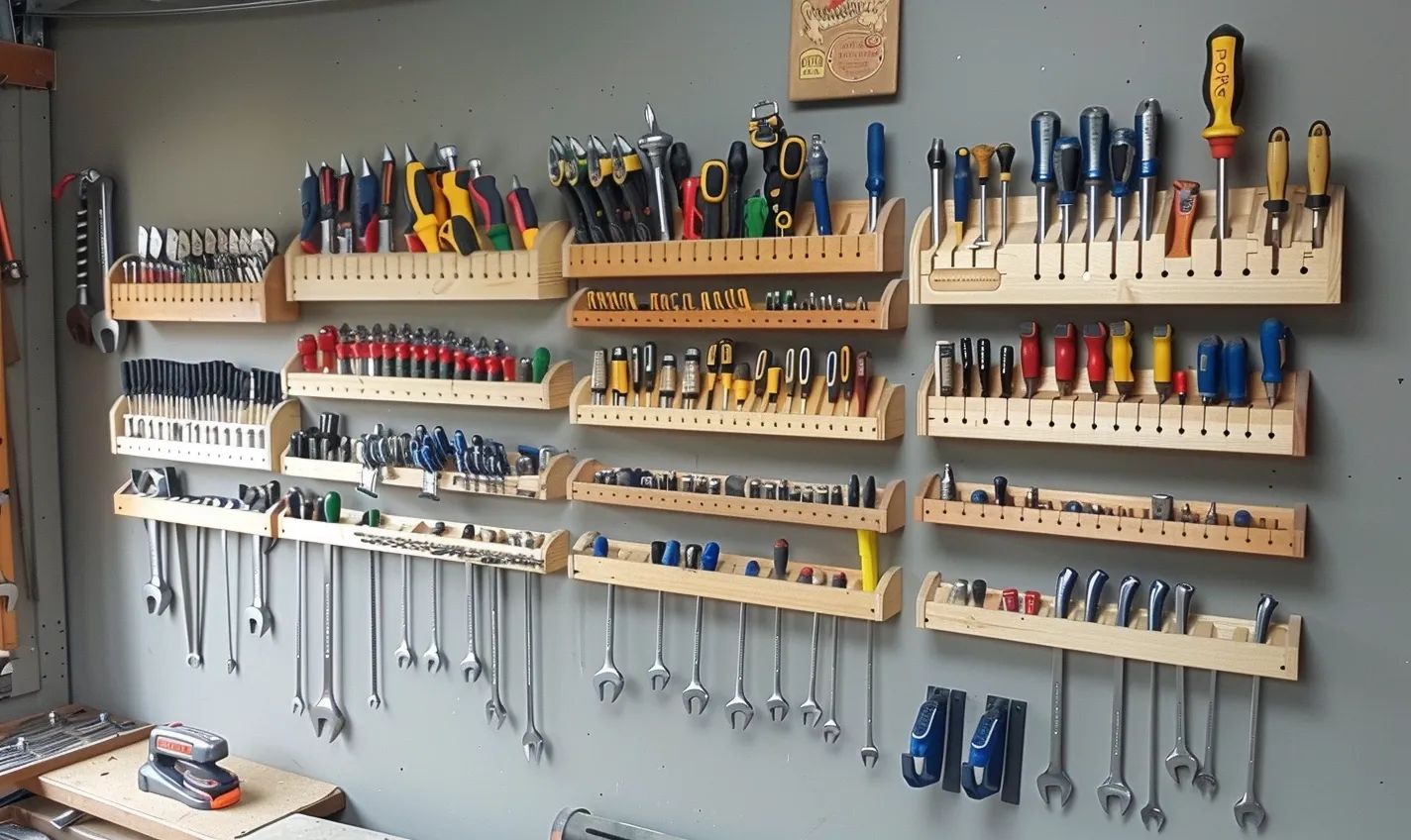
Importance of Organizing Hand Tools in Your Garage Workshop
When working efficiently in your garage workshop, the organization of your hand tools plays a crucial role. An orderly and well-arranged workspace maximizes productivity and enhances overall experience and safety. Here are some reasons why organizing your hand tools is of utmost importance:
Easy Accessibility and Time Savings
Imagine needing a specific tool amidst the chaos of a disorganized workspace. Locating what you need can be frustrating and time-consuming, resulting in delays and wasted energy. By organizing your hand tools, you create a system where everything has a designated place, making it easy to find and grab the tool you need at a moment’s notice. This saves valuable time and lets you focus on the task, ultimately increasing productivity.
Efficiency and Flow
Having a well-organized workspace enables you to work more efficiently. When your tools are properly stored, you can quickly identify and retrieve them, streamlining your workflow. Easy access to your hand tools allows you to smoothly transition between tasks, reducing interruptions and maintaining a steady rhythm. This enhanced flow will enable you to accomplish more in less time.
Safety and Risk Prevention
An organized garage workshop is a safer environment to work in. When hand tools are scattered around, there is a higher risk of accidental injuries. You can keep your tools securely in place by implementing proper storage solutions, such as tool chests or pegboard systems, reducing the likelihood of tripping hazards or injuries caused by sharp or hazardous tools. Additionally, organizing tools helps you maintain them better, preventing damage and extending their lifespan.
Peace of Mind
Imagine walking into a well-organized garage workshop where everything is neatly arranged. The sense of order and cleanliness promotes a calming and focused mindset. Knowing that your tools are in their rightful places eliminates unnecessary stress and distractions, allowing you to concentrate fully on your projects. This peace of mind enhances your creativity and overall enjoyment of your work.
Organizing your hand tools is essential to creating an efficient and accessible garage workshop. From easy accessibility and time savings to enhanced efficiency and safety, the benefits are numerous. With the proper storage solutions and a commitment to maintaining order, you can transform your workspace into a well-oiled machine that supports your passion for DIY projects and repairs.
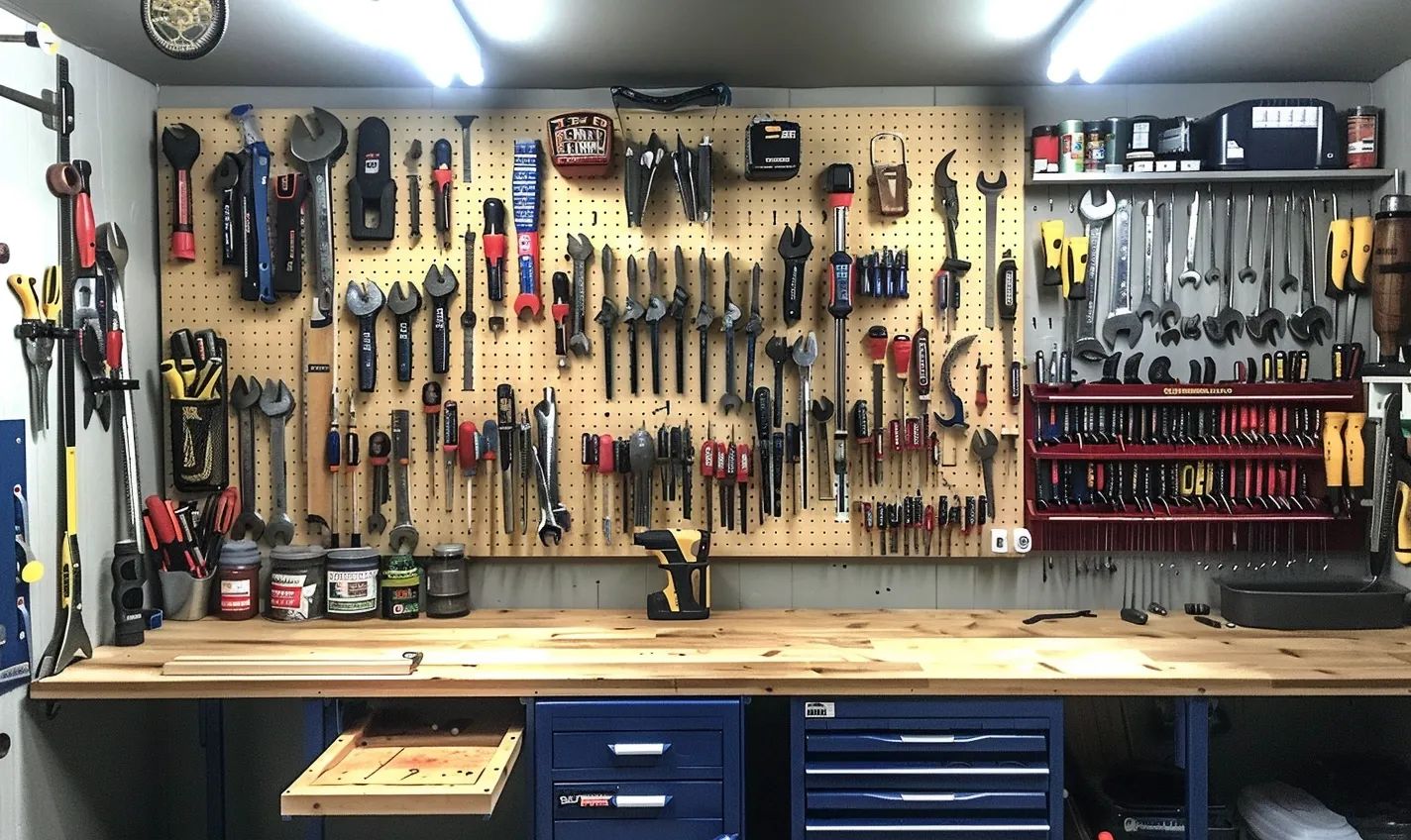
Maximizing Efficiency: Why a Well-Organized Workspace Matters
An organized workspace is essential for hand tools and accessories in your garage workshop. Not only does it make your life easier, but it can also improve your efficiency and productivity. Here’s why a well-organized workspace matters:
Less Time Wasted Searching
Have you ever spent precious minutes searching for a specific tool in a cluttered and disorganized workspace? With a well-organized garage workshop, you can say goodbye to those moments of frustration. By having a designated place for each hand tool, you’ll always know where to find what you need, saving you time and energy.
Streamlined Workflow
Imagine the flow of your work as a river, smoothly and effortlessly moving from one task to another. A well-organized workspace helps create that seamless workflow. By organizing your hand tools logically and systematically, you can quickly move from one project to another without missing a beat. With everything in its place, you can easily access your tools, ensuring your projects are completed efficiently.
Increased Productivity
You’ll likely stay focused and on task when your workspace is clutter-free and well-organized. Each tool has its designated spot, eliminating distractions caused by searching for misplaced items. As a result, you can maximize your productivity and get more done in less time.
Improved Safety
An organized workspace enhances efficiency and contributes to a safer working environment. Picture this: tools neatly stored away, sharp objects adequately secured, and hazardous materials safely stored. You can work with peace of mind by eliminating clutter and potential hazards, reducing the risk of accidents and injuries.
In conclusion, organizing hand tools for efficiency and accessibility is crucial in a garage workshop. A well-organized workspace minimizes time wasted searching for tools, improves workflow, increases productivity, and enhances safety. So, take the time to evaluate your current setup and invest in storage solutions that will transform your garage workshop into an organized haven. Your productivity, efficiency, and overall enjoyment of your projects will thank you!
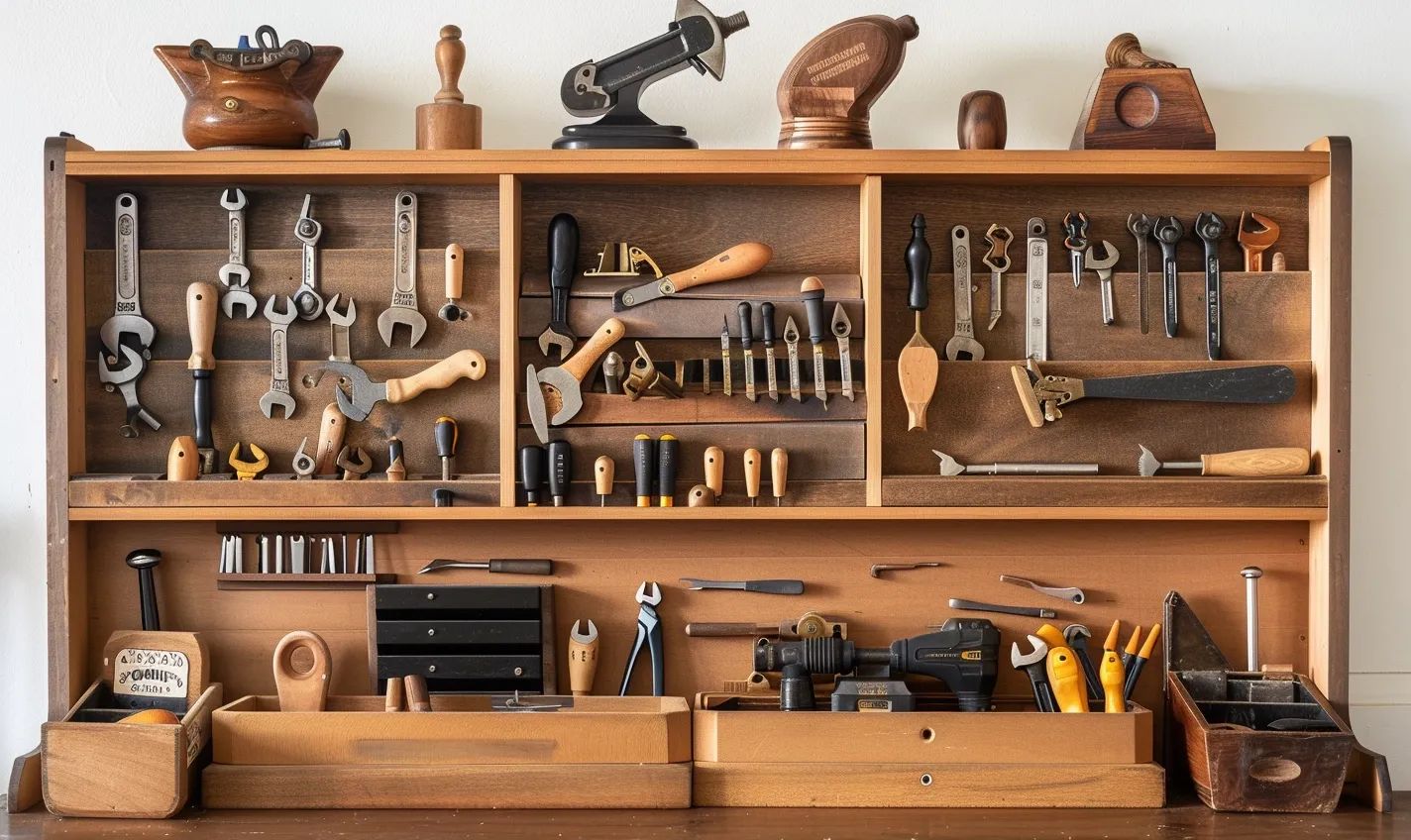
Essential Hand Tool Storage Solutions for Easy Accessibility
When it comes to organizing hand tools in your garage workshop, having efficient and accessible storage solutions is crucial. Not only does proper tool organization save you time and frustration when searching for the right tool, but it also increases your overall productivity. With the proper storage solutions, you can ensure your tools are always within reach and in optimum condition. Here are some essential hand tool storage solutions that can help you achieve this:
Wall-mounted Solutions:
Maximize your workspace by utilizing wall-mounted storage systems. Various options, such as pegboards, slat walls, and magnetic strips, allow you to easily hang and access your most frequently used tools. This keeps them organized and creates visual reminders of their proper places.
Drawer Organizers:
Use drawer organizers to keep small hand tools and accessories tidy and within reach. These dividers are perfect for separating different tools, preventing them from getting mixed up, and making them easily accessible when needed.
Tool Chests and Cabinets:
Tool chests and cabinets are invaluable for more extensive, bulkier hand tools or those requiring extra protection. These sturdy storage units keep your tools secure and provide ample space and compartments for proper organization.
Labeling and Color-Coding:
Save time and minimize confusion by labeling and color-coding your tools. This simple technique lets you quickly identify and locate the right tool for the job, especially when you have many similar-looking tools. Use color-coded stickers or tags for each tool category and label drawers or shelves accordingly.
Remember, the key to effective tool organization is to create a system that works best for you. Assess your needs, available space, and workflow to determine the most practical storage solutions. Don’t be afraid to try different methods until you find the one that optimizes efficiency and accessibility in your garage workshop.
By investing time in organizing your hand tools and utilizing these essential storage solutions, you can create a well-structured workspace that maximizes productivity and minimizes frustration. So, start implementing these ideas today and experience the benefits of an organized and accessible garage workshop!
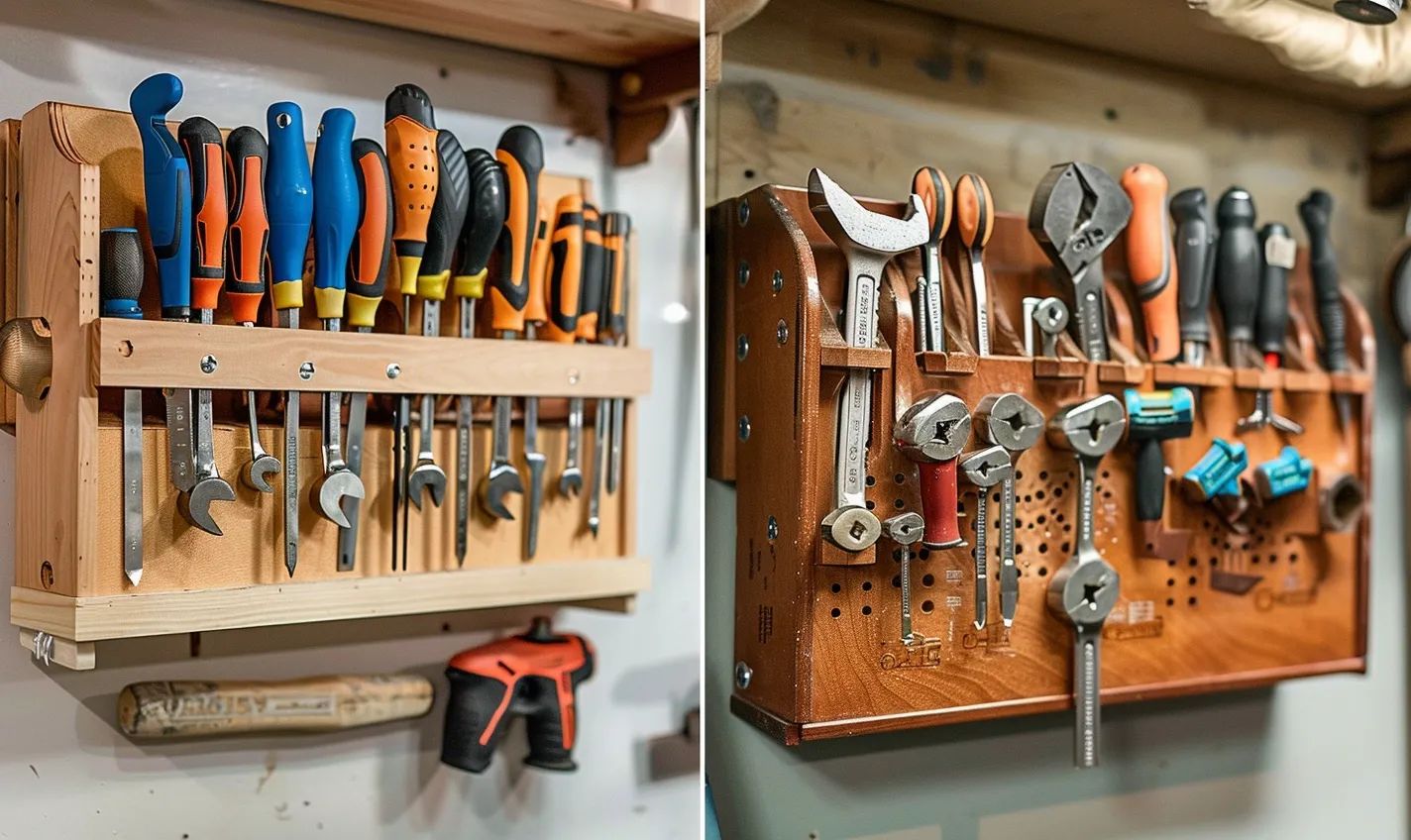
Creating Zones: Divide and Conquer to Streamline Your Workflow
When organizing hand tools for efficiency and accessibility in your garage workshop, one of the most effective strategies is to create distinct zones. By dividing your workspace into different areas based on the type of tools or tasks, you can streamline your workflow and make it easier to find and retrieve the tools you need when you need them.
Why Divide Your Workshop into Zones?
Dividing your workshop into zones has several benefits:
- Improved Efficiency: With specific zones dedicated to different types of tools, you can eliminate the time wasted searching for a particular tool. When everything has its designated space, you can quickly locate and access it, optimizing your productivity.
- Better Organization: Grouping similar tools allows for a more organized and visually appealing workspace. Use wall-mounted solutions, drawer organizers, or pegboard systems to create designated areas for each tool category.
- Enhanced Safety: By categorizing your tools and assigning them to specific zones, you reduce the risk of accidents. Proper storage and organization minimize mishandling or misplacing sharp or hazardous tools.
How to Create Zones in Your Garage Workshop
To create efficient zones in your garage workshop, follow these steps:
- Assess Your Space: Evaluate the available space in your workshop and determine the best layout for your zones. Consider factors like the size and frequency of tool usage to make informed decisions.
- Categorize Your Tools: Take an inventory of your hand tools and categorize them based on their functionality or purpose. Common categories may include power, measuring, cutting, and fastening tools.
- Allocate Storage Solutions: Assign dedicated storage solutions for each tool category. Wall-mounted solutions like racks or shelves are ideal for frequently used tools, while drawer organizers work well for smaller hand tools.
- Label and Color-Code: Label each zone to indicate its purpose and use. Color coding can also be helpful, assigning a specific color to each zone and labeling corresponding tools with matching colors.
With your garage workshop divided into zones, you can maximize efficiency, productivity, and safety while working. Remember to maintain the organization by returning tools to designated zones after use.
Creating zones in your workshop is the key to an organized and efficient workspace. By dividing and conquering, you’ll streamline your workflow, simplify tool retrieval, and maximize your time in the garage.
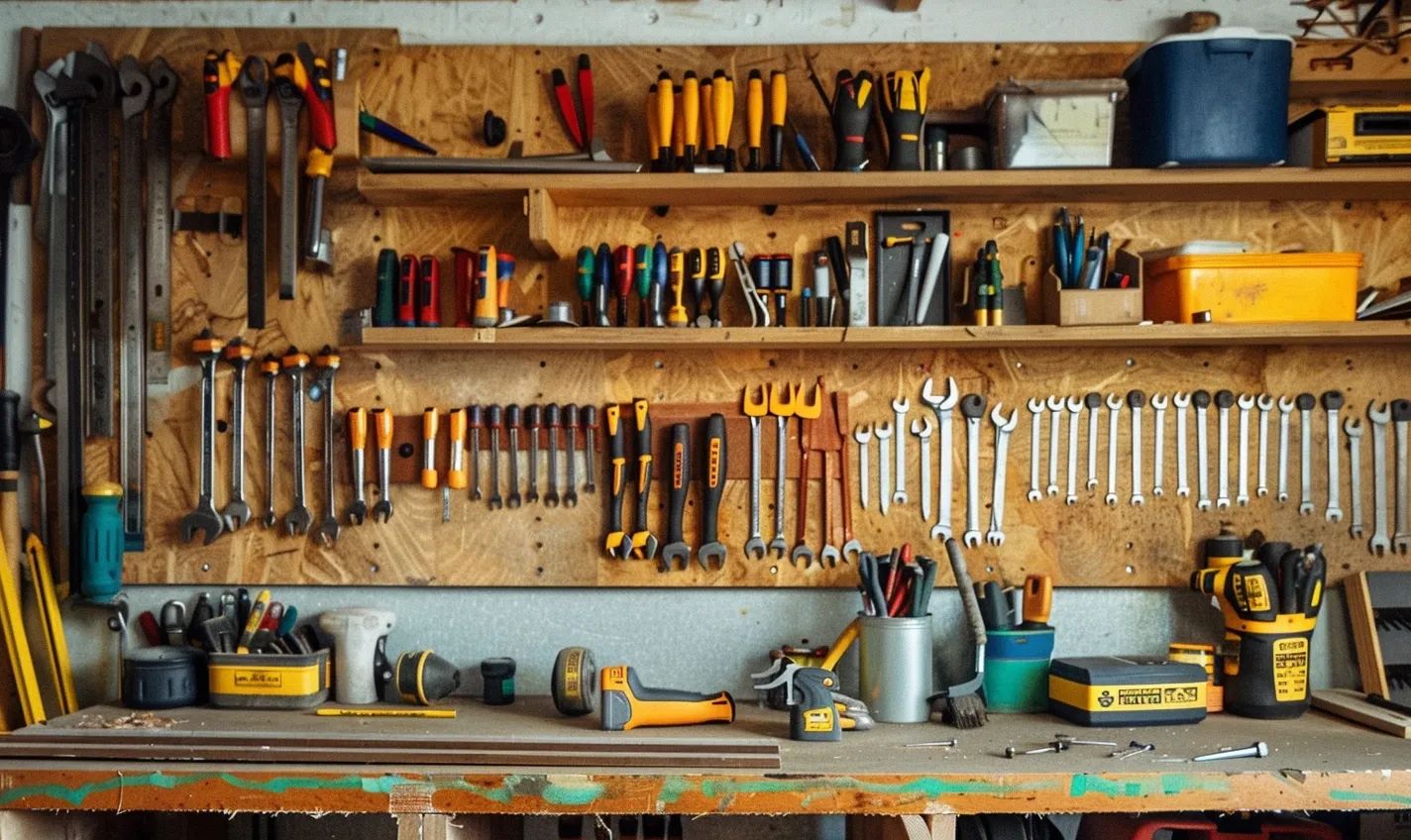
Innovative Wall-mounted Solutions to Optimize Space
Are you tired of rummaging through cluttered toolboxes or dealing with limited workspace in your garage workshop? If so, it’s time to consider innovative wall-mounted solutions that can help you organize your hand tools efficiently while optimizing the available space.
Wall-mounted storage solutions are a game-changer when keeping your tools within reach and creating a visually appealing and organized workshop. These solutions not only save precious floor space but also provide easy accessibility and make it convenient to find the tools you need when you need them. Here are some fantastic options to consider:
Magnetic Tool Strips:
Magnetic tool strips are one of the simplest and most effective ways to organize hand tools. These strips can be easily mounted on the walls, allowing you to hang and display your frequently used tools such as wrenches, screwdrivers, and pliers. With magnetic tool strips, you’ll never have to search for your essential tools again.
Wall Panels:
Wall panels, or Slatwall systems, are versatile storage solutions that utilize horizontal grooves. These grooves can accommodate a range of tool hooks, brackets, and shelves. Installing a wall panel system allows you to customize your storage space according to your needs. From hammers to drills, everything will have its designated spot, making it easy to locate your tools at a glance.
Pegboards:
Pegboards are a classic choice for organizing hand tools. These perforated boards allow you to hang your tools using hooks, bins, and brackets. The versatility of pegboards will enable you to arrange and rearrange your tools as needed. Additionally, you can add shelves or wire baskets to store smaller items or use the board as a backdrop for labeling and color-coding, further enhancing efficiency.
Tool Racks and Shelves:
Another option to optimize space is by utilizing tool racks and shelves. These can be mounted on the walls and offer a practical way to store more extensive tools or items that don’t easily fit on pegboards or magnetic strips. Tool racks with multiple hooks or adjustable shelves allow you to keep your tools organized and easily accessible.
By implementing these innovative wall-mounted solutions, you can transform your garage workshop into a well-organized space where every tool has its rightful place. Whether you choose magnetic tool strips, wall panels, pegboards, or tool racks and shelves, the key is to customize the storage according to your needs and workflow. With an efficient and accessible layout, you can say goodbye to wasted time searching for tools and hello to increased productivity in your garage workshop.
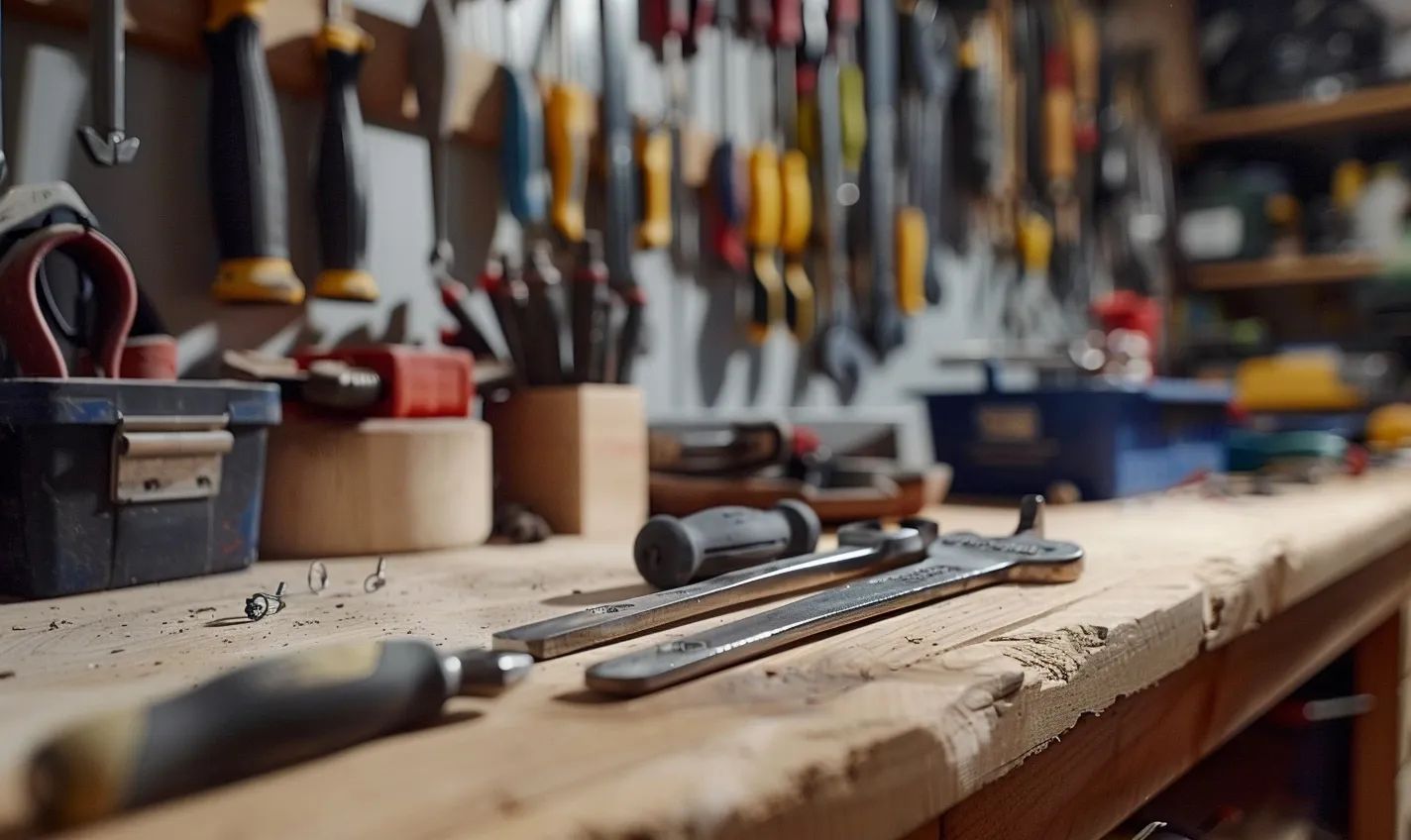
Drawer Organizers: Keeping Small Tools Tidy and Within Reach
When organizing your hand tools in your garage workshop, it’s essential to have a system that keeps everything tidy and easily accessible. One tool storage solution that can help you achieve this is drawer organizers.
Why Use Drawer Organizers?
Drawer organizers are a simple yet effective way to keep your small tools in order. Here are a few reasons why you should consider incorporating them into your workshop:
- Increased Efficiency: With dedicated compartments for each tool, you can quickly locate the one you need without wasting precious time searching through cluttered drawers.
- Improved Organization: Drawer organizers provide structure and prevent tools from getting mixed up or tangled, ensuring everything has its designated place.
- Enhanced Accessibility: With drawer organizers, your tools are always within reach, minimizing the need to dig through piles or rummage through multiple drawers.
- Protection and Maintenance: By separating your tools into individual compartments, drawer organizers help prevent scratches, dents, and other damage that could occur when items are jumbled together.
Choosing the Right Drawer Organizers
Before investing in drawer organizers, consider the sizes of your tools and the available drawer space in your workshop. Here are a few options to consider:
- Adjustable dividers: These versatile organizers allow you to customize the compartment sizes to accommodate various tool sizes and shapes.
- Foam inserts: Foam inserts provide a cushioning effect, protecting your tools from impact and keeping them securely in place.
- Modular systems: Modular drawer organizers can be easily reconfigured or expanded as your tool collection grows.
Tips for Organizing with Drawer Organizers
Here are a few handy tips to make the most of your drawer organizers:
- Separate by type: Group similar tools together, such as screwdrivers, pliers, or wrenches, to quickly identify and retrieve your needs.
- Arrange by frequency of use: Store frequently used tools in the most accessible compartments for maximum efficiency.
- Label compartments: Use labels or color-coded stickers to identify the contents of each compartment, making it even easier to find the right tool quickly.
Integrating drawer organizers into your garage workshop allows you to streamline your workflow, save time, and keep your small tools tidy and within reach. Remember to choose the right organizers for your needs and follow a thoughtful organizing strategy for maximum effectiveness.
Stay tuned for expert tips on organizing hand tools in your garage workshop!
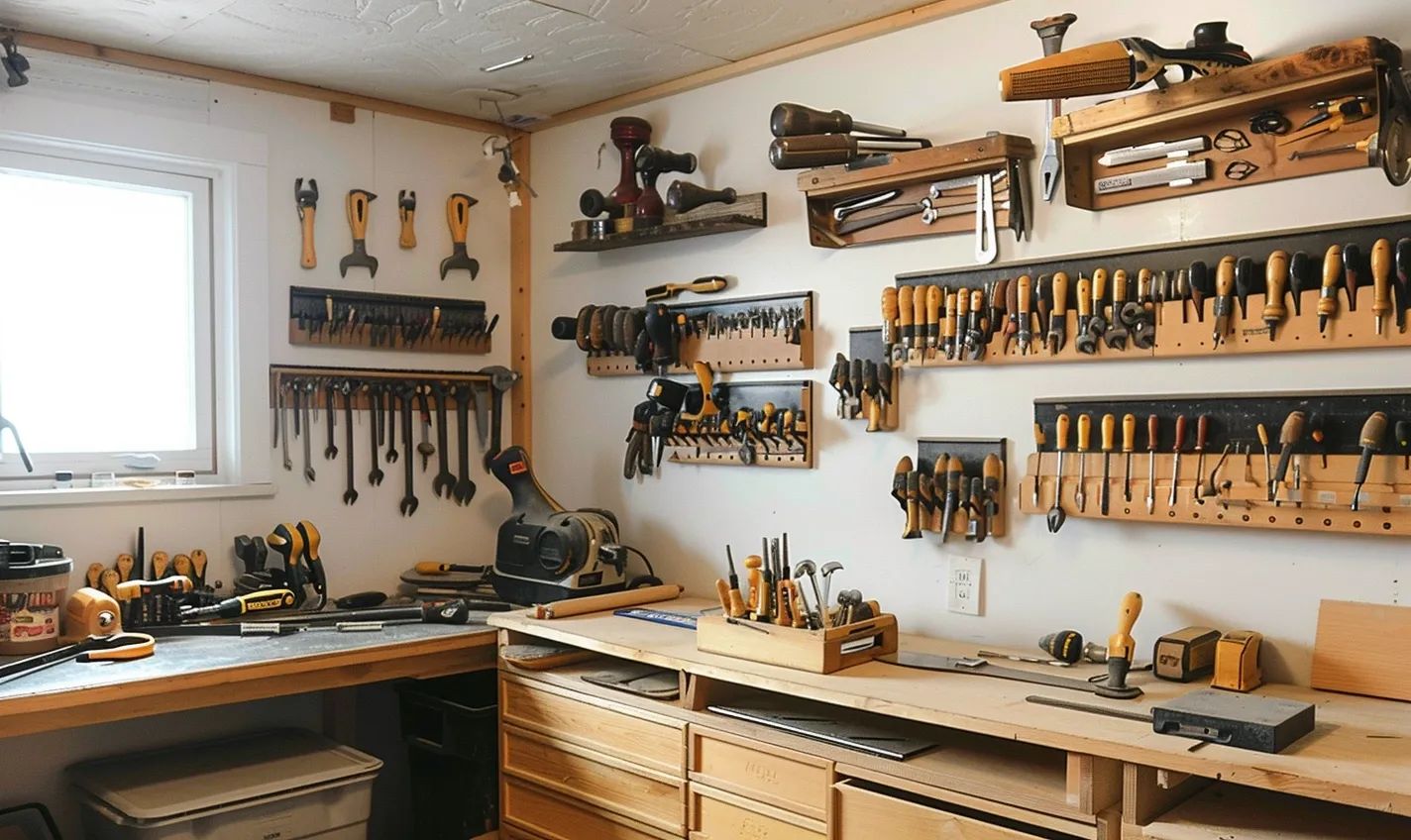
The Benefits of Pegboard Systems for Versatile Tool Storage
The pegboard system is one storage solution that should not be overlooked when organizing hand tools in your garage workshop. With its versatility and accessibility, pegboards offer several benefits that significantly enhance your workflow and make your tools easily accessible.
So, what exactly are the benefits of using pegboard systems for tool storage? Let’s take a closer look:
Flexibility and Customization
Pegboards are incredibly flexible, allowing you to arrange your tools in any configuration that suits your needs. With hooks, brackets, and shelves, you can easily customize your pegboard to accommodate tools of various sizes and shapes. This flexibility ensures that your tools are always within reach and neatly organized.
Visual Organization
One of the key advantages of using a pegboard system is the visual organization it provides. By hanging your tools on the pegboard, you can instantly see the entire inventory of your hand tools at a glance. This visual organization saves you time searching for specific tools and helps prevent misplacing them.
Space Optimization
Pegboards are excellent space-saving solutions for garages with limited room. You can maximize your workspace and keep your floor area clear of clutter using vertical wall space. This allows for efficient movement and prevents accidents caused by tripping over tools.
Quick and Easy Access
When you have a pegboard system, accessing your tools becomes a breeze. Whether grabbing a hammer or a wrench, you can quickly locate and retrieve your desired tool without rummaging through drawers or searching in toolboxes. This quick and easy access improves overall efficiency and productivity in your garage workshop.
Adaptability for Changing Needs
Another advantage of using pegboard systems is their adaptability to changing needs. As your tool collection grows or changes, you can easily rearrange or add hooks and shelves to accommodate new tools. This adaptability ensures that your organizational system remains effective and efficient in the long run.
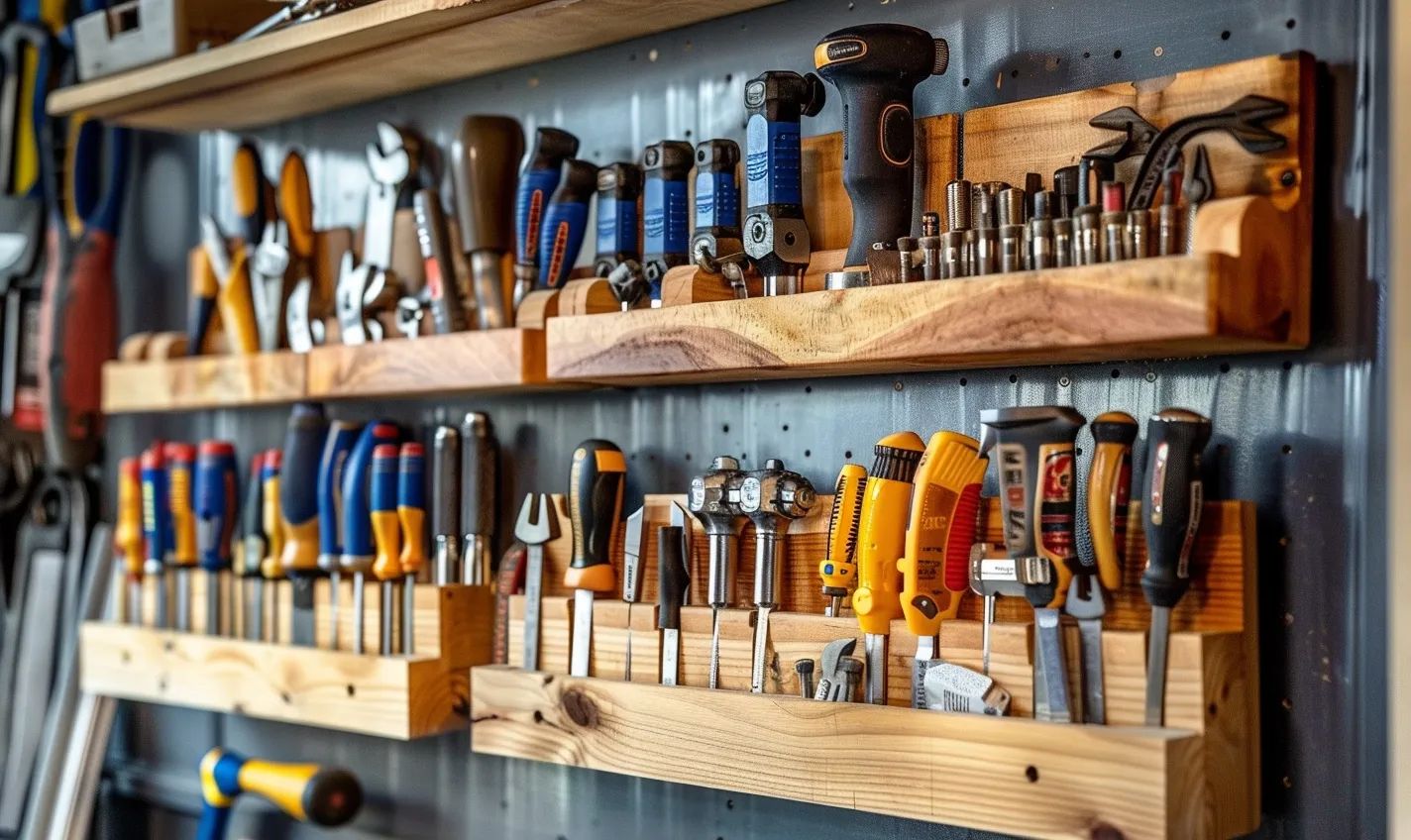
Utilizing Tool Chests and Cabinets to Keep Tools Secure
In any garage workshop, organizing your hand tools is essential for efficiency and accessibility. While wall-mounted solutions, drawer organizers, and pegboard systems are great for storing smaller tools and creating a visual display, more extensive and valuable tools require a different storage solution. Investing in tool chests and cabinets is an excellent choice for these tools.
Benefits of Tool Chests and Cabinets
Tool chests and cabinets offer several advantages when it comes to storing your hand tools:
- Secure Storage: Tool chests and cabinets typically come with locks, providing an added layer of security to protect your valuable tools from theft or unauthorized access.
- Organization: These storage solutions often feature multiple drawers, shelves, and compartments, allowing you to categorize and organize your tools based on size, type, or frequency of use.
- Accessibility: With tool chests and cabinets, your tools are neatly stored and within reach whenever needed. No more searching through cluttered workbenches or rummaging through piles of tools.
- Protection: Tool chests and cabinets are designed to protect your tools from dust, moisture, and other potentially damaging elements. This ensures that your tools are in optimal condition and always ready for use.
Whether you opt for a portable tool chest with wheels, a stationary cabinet, or a combination of both, these storage solutions can drastically improve the efficiency of your garage workshop.
Choosing the Right Tool Chest or Cabinet
When selecting a tool chest or cabinet for your workshop, consider the following factors:
- Size and Capacity: Assess the number and size of your hand tools to determine the appropriate size and storage capacity to accommodate all your tools.
- Durability: Look for tool chests and cabinets made from sturdy materials, such as steel, to ensure long-lasting durability.
- Mobility: If you need to move your tools around frequently, opt for a tool chest with wheels for easy portability.
- Organization Features: Consider the layout and configuration of the drawers and shelves to ensure they meet your organization’s needs and preferences.
- Budget: Set a budget range and explore options within that range to find a tool chest or cabinet that offers the best value for your money.
Investing in the right tool chests and cabinets lets you keep your hand tools secure, organized, and readily accessible, saving you time and frustration in your garage workshop. So, why not take the next step in optimizing your workspace and give your tools the home they deserve?
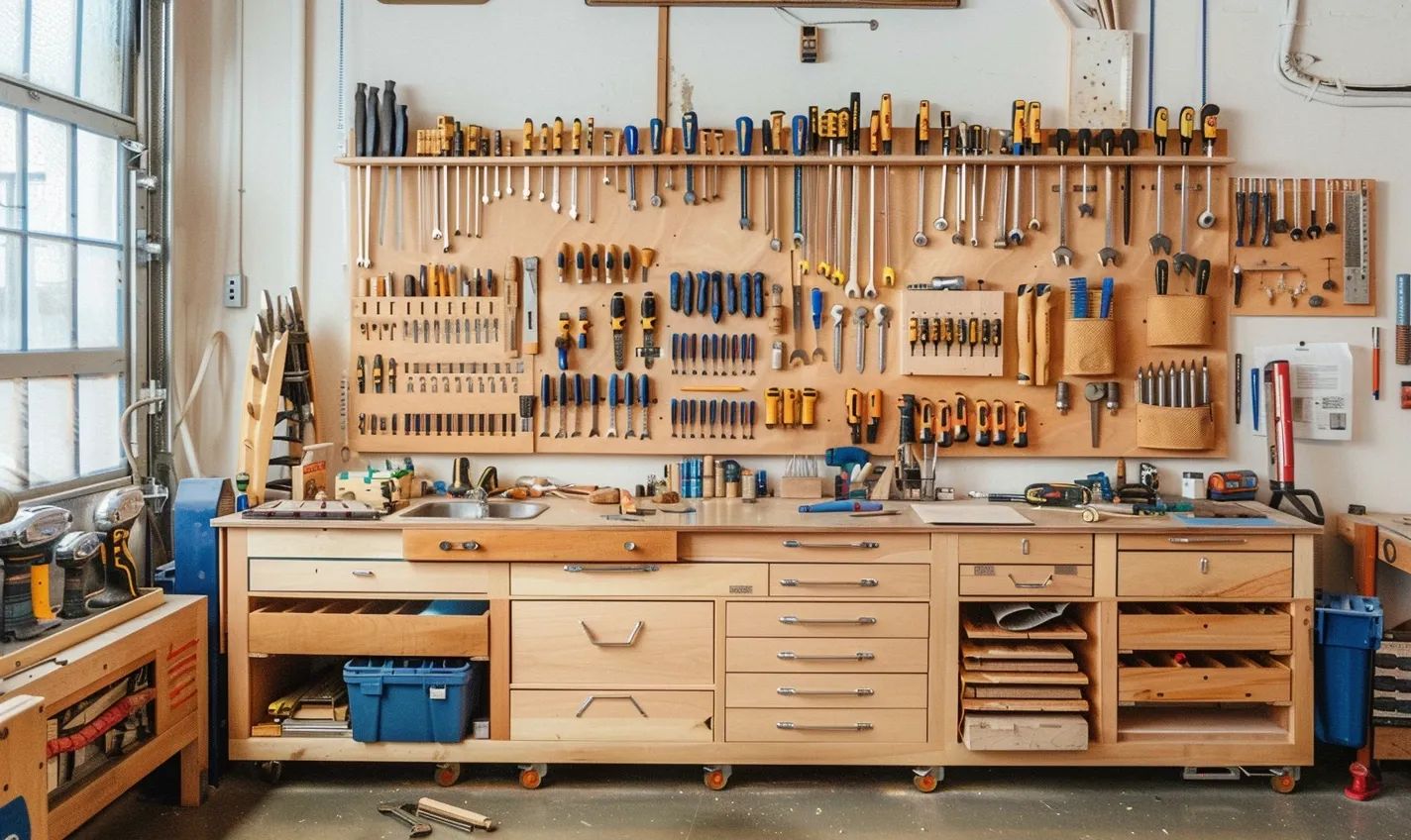
The Importance of Proper Tool Maintenance and Care
When it comes to organizing your hand tools in the garage workshop, it’s not just about finding the proper storage solutions and keeping everything tidy. Another vital aspect often overlooked is proper tool maintenance and care. By taking the time to maintain and care for your tools, you can ensure their longevity, functionality, and safety. Here are a few reasons why this is so crucial:
Extend the Lifespan of Your Tools:
Regular maintenance, such as cleaning and lubricating your hand tools, can help extend their lifespan. Removing dirt, rust, and debris prevents corrosion and damage that could render your tools unusable. Additionally, lubricating moving parts reduces friction and wear, allowing your tools to perform at their best for longer.
Ensure Optimal Performance:
A well-maintained tool is a reliable tool. By keeping your tools in good condition, you can ensure they perform optimally. Sharp blades, clean handles, and functional moving parts contribute to efficient and practical work. Whether you’re tightening screws, cutting through materials, or measuring with precision, well-maintained tools make your tasks easier and more accurate.
Promote Safety:
Properly maintained tools are safer to use. For example, a dull blade can slip or get stuck, increasing the risk of accidents. By sharpening your tools regularly, you reduce the chances of mishaps and injuries. Additionally, inspecting your tools for any defects or damages can help identify potential hazards and prevent accidents before they occur.
Save Time and Money:
Investing a little time in tool maintenance can save you time and money in the long run. Keeping your tools in good condition minimizes the need for costly repairs or replacements. Additionally, well-maintained tools are more efficient, allowing you to quickly and effectively complete your tasks.
Reflects Professionalism and Pride:
Taking proper care of your tools demonstrates your professionalism and pride in your craft. When clients or colleagues see that you have well-maintained tools, it reflects positively on your work and attention to detail. It also shows that you value and take pride in using your tools correctly.
Proper tool maintenance and care should be integral to your garage workshop organization. By extending the lifespan of your tools, ensuring optimal performance, promoting safety, saving time and money, and reflecting professionalism, you set yourself up for success in your projects. So, make it a habit to include tool maintenance in your garage workshop routine and reap the benefits of efficient and accessible hand tools.

Labeling and Color-Coding: Time-Saving Techniques for Quick Identification
When organizing your hand tools in your garage workshop, one of the most effective techniques for efficient and accessible storage is labeling and color-coding. This simple yet powerful system can save time and effort by quickly identifying tools and their designated storage locations.
Labeling
Labeling your hand tools is a straightforward and practical way to ensure everything has its proper place. By using labels, you create a visual reminder of where each tool belongs, making it easier to find and return items after use. Here are a few critical tips for adequate labeling:
- Use clear and legible labels: Opt for labels that are easy to read, ensuring that they won’t fade or smudge over time.
- Include specific tool names: Rather than general categories, label each tool with its particular name to avoid confusion.
- Label storage containers and individual tools: Ensure consistency by labeling the storage containers and the tools themselves, especially those that may be stored separately.
Color-Coding
Color-coding takes organization to the next level by visually grouping tools based on their function, size, or frequency of use. By assigning a specific color to each category, you create an intuitive system allowing quick identification and retrieval of tools. Consider these suggestions when color-coding your hand tools:
- Choose a limited range of colors: To avoid confusion, select a small number of colors that differentiate between categories or groups.
- Assign colors by categories: Determine a logical color association for each category, such as blue for measuring tools, red for cutting tools, and green for fastening tools.
- Use colored tape or paint: Apply colored tape or paint to your hand tools’ handles or storage containers to create a consistent and visible color-coding system.
By combining labeling and color-coding techniques, you can streamline your workflow and enhance the overall efficiency of your garage workshop. When you need a specific tool, you’ll be able to find it at a glance, saving you valuable time and reducing frustration.
Remember, organizing your hand tools is not just about neatness; it’s about maximizing productivity and creating an environment that allows you to focus on your projects. So, invest a little time in implementing labeling and color-coding systems and experience the benefits of efficient and accessible tool storage.

Prioritizing Safety: Storing Sharp and Hazardous Tools Properly
Safety should always be a top priority When organizing hand tools in your garage workshop. Storing sharp and hazardous tools properly prevents accidents and ensures easy accessibility when you need them. Here are some tips to help you maintain a safe and organized workspace:
Separate sharp tools from other hand tools
Keeping sharp tools, such as chisels, saws, and knives, separate from other hand tools is crucial for safety. Store them in a dedicated container or drawer with slots or sheaths to prevent accidental cuts or injuries.
Use protective covers for sharp blades.
Protecting the sharp blades of tools like saws and chisels is essential to avoid accidental cuts. Use blade covers or guards to keep the edges covered when not used.
Store hazardous tools in lockable cabinets
Hazardous tools, such as power drills, grinders, or soldering irons, should be stored in lockable cabinets to prevent access by unauthorized individuals. This measure ensures safety and prevents potential accidents.
Secure loose or extendable tool parts.
Tools with extendable or detachable parts, like adjustable wrenches or socket sets, should be adequately secured when not in use. Store them in tool organizers or cases with compartments to prevent loose parts from causing accidents or injuries.
Keep flammable materials and chemicals separate.
If you store flammable materials or chemicals in your garage workshop, keeping them separate from your hand tools is essential. Store them in designated cabinets away from potential ignition sources to minimize fire hazards.
Have a designated first-aid kit.
Accidents can still happen, even with proper safety measures in place. Make sure to have a well-stocked first-aid kit readily available in your workshop to provide immediate medical attention in case of minor injuries.
Organizing your hand tools with safety in mind creates a more efficient workspace and reduces the risk of accidents and injuries. Remember, a safe workshop is a productive workshop!
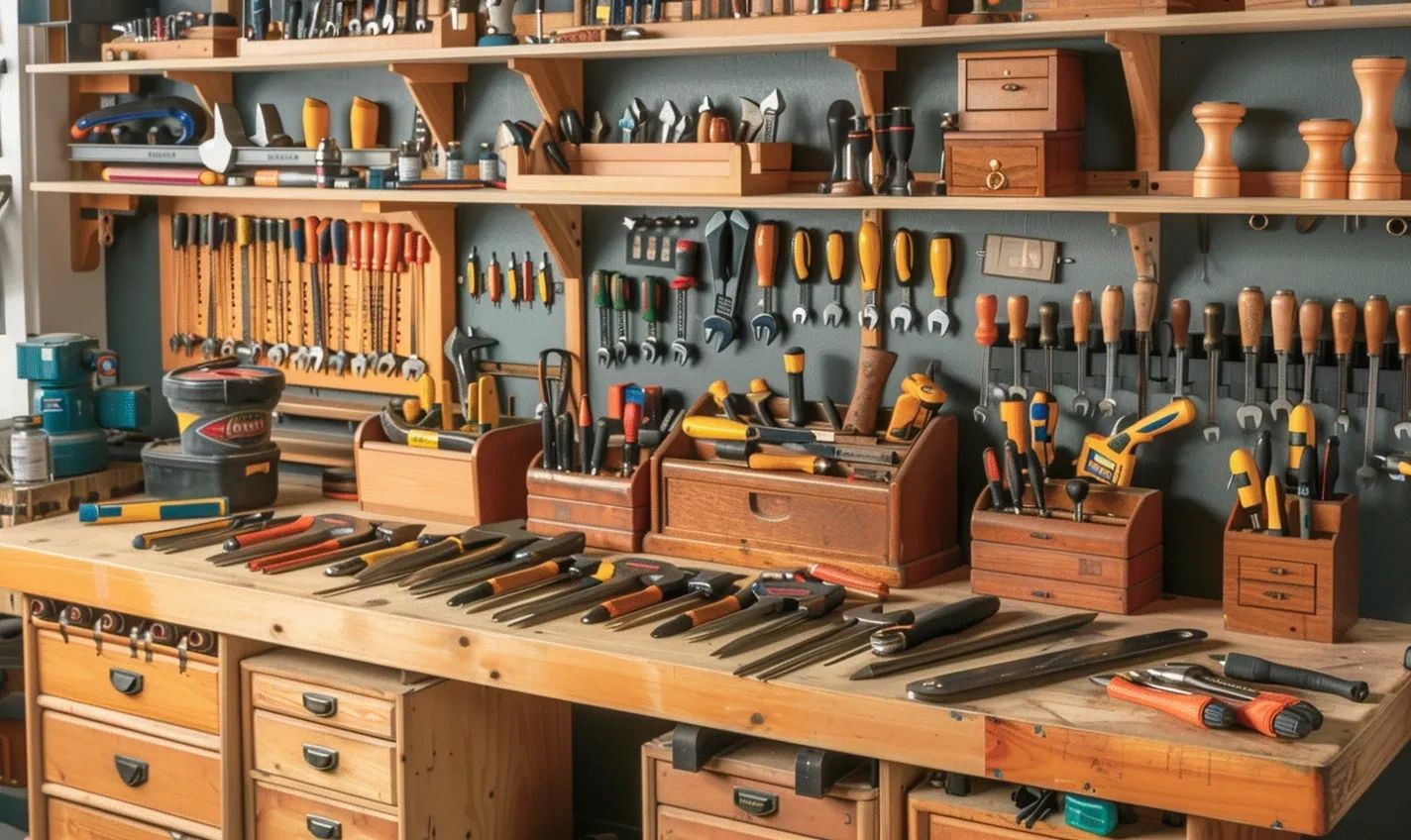
Expert Tips for Organizing Hand Tools in Your Garage Workshop
When it comes to your garage workshop, having an organized space is crucial for maximum efficiency and accessibility. You don’t want to waste time searching for tools or risk injury by tripping over clutter. With the right-hand tool storage solutions and organizational techniques, you can streamline your workflow and create a well-functioning workspace. Here are 12 expert tips to help you organize your hand tools effectively:
Sort and categorize your tools
Start by grouping your hand tools based on their function and type. This will make it easier to find what you need when needed. For example, you could separate screwdrivers, wrenches, and hammers into different categories.
Utilize a pegboard system.
Hang a pegboard on the wall to store frequently used hand tools. Attach hooks and holders to keep each tool in its place. This provides easy access and a visual reminder to return the tools to their designated spots.
Invest in a tool chest or cabinet.
Tool chests and cabinets offer secure storage for hand tools, preventing them from getting damaged or lost. Choose one with multiple drawers and compartments to keep everything organized and easily accessible.
Use drawer organizers
Invest in drawer organizers for small hand tools such as screwdrivers, pliers, and wrenches. These will keep them sorted and prevent them from tangling together.
Label and color-code
Use labels and color-coded tags to identify and locate your tools quickly. This saves time and ensures that tools are returned to their designated spaces.
Create zones
Organize your workshop into functional zones, such as a cutting area, a measuring area, and a power tool area. This division will help you streamline your workflow and reduce wasted time between tasks.
Utilize wall-mounted solutions
Wall-mounted racks, shelves, and magnetic strips are efficient ways to store and display your hand tools. They save space and make tools easily accessible at eye level.
Prioritize safety
When storing sharp or hazardous tools, ensure they are adequately secured and out of reach by children and pets. Consider using lockable cabinets or dedicated storage solutions for extra safety.
Clean and maintain your tools regularly
To prolong the lifespan of your hand tools, make it a habit to clean them after each use and perform regular maintenance. This will prevent rust and ensure they remain in good working condition.
Streamline your tool collection.
Do you have duplicates or unused tools gathering dust? Consider donating or selling them. Keeping only the essential tools will give your workshop more space and less clutter.
Keep a digital inventory.
Make a list or take photos of your hand tool collection. This inventory will serve as a reference, helping you track what you have and what you may need to replace or upgrade.
Regularly reassess and optimize
As your workshop evolves and your needs change, periodically reassess your hand tool organization system. Optimize it to ensure it continues to meet your workflow requirements and maximizes efficiency.
You’ll transform your garage workshop into a well-optimized space by implementing these expert tips for organizing your hand tools. Efficiency and accessibility will become second nature, allowing you to focus on your projects rather than searching for tools. So, why wait? Start organizing your hand tools today!
Conclusion
In conclusion, organizing hand tools for efficiency and accessibility is crucial in creating an optimized garage workshop. By implementing a systematic approach to tool organization, you can save time, increase productivity, and enhance your overall working experience.
Start by decluttering and sorting your tools into categories based on their functionality. Investing in quality toolboxes, wall-mounted racks, and pegboards will keep your tools neatly organized and easily accessible, saving you from wasting time searching for the right tool.
Use labels or color coding systems to streamline the organization process further further. This will help you quickly identify and locate the specific tools you need, reducing the chances of misplacing or losing them. Additionally, consider investing in tool rolls or trays to organize smaller hand tools within your toolbox or drawer.
Regular maintenance and cleaning of your tools are also essential. Not only will it extend their lifespan, but it will also prevent them from taking up unnecessary space. A clean, well-organized workspace will create a more enjoyable and efficient working environment.
Remember, the key to an efficient and accessible hand tool organization system is consistency. Make it a habit to return tools to their designated storage spots after each use. Doing so will improve your workshop’s functionality and save valuable time and energy when undertaking future projects.
Organizing hand tools may seem small, but it can significantly impact your productivity and efficiency in your garage workshop. So, take the time to create an organized and accessible setup, and you’ll reap the benefits of a streamlined and successful work environment.
Frequently Asked Questions (FAQs)
Question 1: How can I organize my hand tools for efficiency and accessibility?
To organize hand tools effectively, start by categorizing them based on their function. Use pegboards, tool belts, magnetic strips, and drawer dividers. Keep frequently used tools within easy reach and label everything for quick identification.
Question 2: What are the benefits of organizing hand tools in a garage workshop?
Organizing hand tools in a garage workshop enhances efficiency and productivity. It saves time searching for tools, prevents accidents caused by misplaced tools, and maximizes available space. It also improves workflow and helps to maintain a clean and organized workspace.
Question 3: How can I ensure accessibility for my hand tools?
To ensure accessibility, consider the frequency of tool usage. Place frequently used tools in easily accessible locations like toolboxes, wall-mounted racks, or on a pegboard. Keep less regularly used tools in labeled drawers or storage containers to free up space.
Question 4: Which storage options are best for organizing hand tools?
The best storage options for organizing hand tools depend on personal preferences and space availability. Pegboards with hooks provide easy access and visibility. Tool cabinets or chests keep tools secure and protected. Magnetic strips are great for small metal tools, and tool belts offer portability for on-the-go tasks.
Question 5: How can I prevent my hand tools from rusting?
To prevent hand tools from rusting, ensure they are clean and dry before storing them. Apply a thin coat of rust-preventive oil or silicone spray, especially for metal tools. Store tools in a dry environment, away from moisture. Utilize dehumidifiers or moisture-absorbing packs if necessary.
Question 6: What additional tips for organizing hand tools in a garage workshop?
Some additional tips for organizing hand tools include using tool foam inserts to create custom cutouts for each tool, implementing shadow boards to ensure tools are returned to their designated spots, and regularly decluttering and reevaluating tool storage solutions for maximum efficiency.